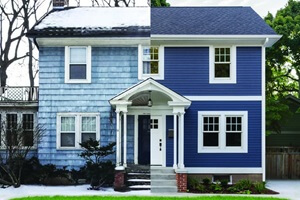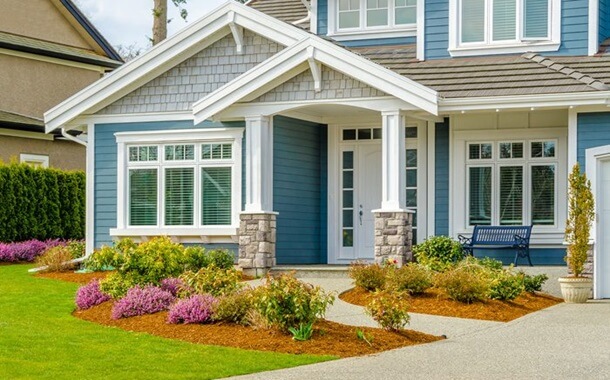How Much Does New Siding Cost?
Last Updated on April 9, 2024
Written by CPA Alec Pow | Content Reviewed by ![]() CFA Alexander Popinker
CFA Alexander Popinker
Installing new siding is one of the most impactful upgrades you can make to transform your home’s curb appeal, comfort, and value. With so many siding options now available, from vinyl to fiber cement to natural stone, it’s important to understand the associated costs for materials, labor, and installation.
Expect to spend $3,000 to $15,000+ to install new siding on the average single-family suburban home. Prices range from $3 per square foot for basic vinyl siding up to $25 per square foot for premium stone veneer siding. Location, home size, complexity, tear-off needs, and material grades all impact your total investment.
We’ll closely examine popular siding materials, pricing factors, optional add-ons, and smart ways to balance aesthetic appeal with affordability. With proper planning and material choices, you can give your home a beautiful new facade without breaking the budget.
How Much Does New Siding Cost?
The specific siding material chosen makes the biggest impact on your project’s total installed cost. Here are the main options with average per square foot installed prices:
- Vinyl siding – Ranges from $3 to $8 per sq. ft. Vinyl is loved for its low maintenance, durability, longevity, and wide range of color and style options. It provides the most affordable siding solution.
- Fiber cement siding – Runs $6 to $13 per sq. ft. Highly impact-resistant and praised for its dimensional stability and resistance to rot, termites, fire, and moisture. Requires periodic repainting.
- Wood siding – Costs around $7 to $12 per sq. ft. Prized for its traditional appearance, wood offers a classic charm. But it does require intensive, regular staining/sealing to protect it.
- Aluminum siding – Approximately $5 to $10 per sq. ft. Lightweight yet durable, aluminum siding resists dents, won’t rust, and has a long service life. Simple upkeep.
- Steel siding – Prices from $8 to $14 per sq. ft. The strongest and most impact-resistant option, steel will not warp, dent, or crack easily. But deep scratches can rust if not recoated.
- Brick veneer siding – Runs $10 to $20 per sq. ft. Brick exudes timeless beauty and prestige. But it is very heavy and requires structural enhancements to buildings. Time-consuming installation.
- Stone veneer siding – Costs $15 to $25 per sq. ft. Natural stone creates an elegant finish but is quite heavy and important to install properly. One of the more expensive siding choices.
- Composite siding – $8 to $12 per sq. ft. Made from mixed recycled materials like wood pulp fibers, composite siding is an eco-friendly alternative to natural wood. Durability can vary by formulation.
According to Today’s Homeowner, siding your house costs between $5,075 and $20,300, with an average cost of siding a house being $12,690 for material and labor.
Hover writes that the cost of vinyl siding installation ranges from $2.50 to $10.75 per square foot. The same website states that homeowners with a 1,000-square-foot home can expect to pay between $2,150 and $5,250 in labor costs alone.
Modernize says that the cost to remove old siding can range from $1,000 to $3,000 or more. Repairs before installation can vary widely, from a few hundred dollars for minor fixes to several thousand dollars for more extensive repairs
Factors That Impact Total Siding Installation Costs
Several important considerations affect total project cost:
- Total exterior wall surface area needing new siding, which determines required siding amounts. Larger homes cost more.
- Removal and disposal of old existing siding first, which adds demolition labor and landfill fees.
- Condition of the underlying exterior walls and sheathing. Any repairs add cost.
- Complexity factors like multi-level homes, difficult access areas, and architectural detailing. More complexity equals more labor.
- Geographic location which impacts prevailing tradesman wages and material availability. Urban areas cost more.
- Chosen siding material, with premium natural stone, brick, and fiber cement adding more expense than basic vinyl or aluminum. Prioritize visible streetside areas for premium materials and vinyl on the side and rear areas to balance cost with curb appeal.
Additional Siding Expenses
Some supplementary costs that might arise with a siding renovation:
- Insulation upgrades – New exterior sheathing presents the ideal opportunity to add extra insulation for improved energy efficiency. This typically adds $500 to $2,000.
- Electrical modifications – Any exterior wiring, outlets, or lighting fixtures affected by thicker new siding must be extended to compensate. Budget $200 to $500 for an electrician’s time.
- Rot repairs – Replacing any boards or wall structural elements with moisture degradation or pest damage noticed once old siding removed. Could be several hundred for minor repairs up to $5,000+ for an extensive wall rebuild.
- Added accessories – New vented soffits, decorative trim pieces, flashing, caulking, and chaulking all marginally increase job costs but provide important protection. Budget an extra 5-10% of material costs for these items.
- Finishing – Unfinished wood or fiber cement siding will require protective paint, stain, or sealer for weather resistance and lasting visual appeal. Budget $1,000 to $3,000 for coating application.
You might also like our articles about the cost of LP SmartSide siding, Hardie Board siding, or CertainTeed siding.
How to Estimate Your Siding Project Cost
Carefully measuring the total exterior wall square footage needing new siding is the crucial first step for obtaining accurate contractor quotes:
- Note the length and height measurements of each exterior house wall section needing new siding, including the garage. Create a sketch to map it out.
- Use measurements to calculate the total surface area in square feet of all sections combined.
- Multiply the total square footage result by $5 to $25 per sq. ft. depending on your desired siding material grade to estimate the cost range.
Get written bids from at least 3 reputable siding contractors using your square footage totals to compare pricing competitively.
Ways to Save on New Siding Installation
 If strapped for budget, consider these strategies to reduce new siding costs without sacrificing quality:
If strapped for budget, consider these strategies to reduce new siding costs without sacrificing quality:
- Choose durable yet affordable vinyl or aluminum siding over premium natural stone options when possible. Use stone only on select accent walls.
- Mix siding materials, using higher grades like fiber cement on front streetside facades but budget vinyl on rear and side sections less visible from curbside.
- Install expanded insulation behind the new siding yourself using DIY instructional videos, then have siding contractor cover over your work. Combines cost savings.
- Select simple streamlined siding styles requiring less precise cuts and customization. Skip ornate designs.
- Opt for slimmer, low-profile siding that efficiently covers more surface area quicker, using fewer pieces.
- Stain, seal, or paint unfinished wood siding yourself on a yearly basis as needed to prolong life.
- Tear off old siding yourself if safely allowable based on asbestos testing. Otherwise, negotiate a discount if you can haul the debris away for the contractor.
Final Words
Investing in new home siding can pay dividends for decades through increased property value, improved energy efficiency, visual curb appeal, and protection from weathering. Carefully weigh the costs and benefits of various siding materials based on your particular budget, tastes, and improvement goals.
With smart planning and forethought, you can achieve beautiful, impactful results regardless of project cost constraints. Just be sure to get every expected expense and assumption in writing upfront when requesting bids from contractors.
Frequently Asked Questions
How much siding do I need for a 2000 sq ft house?
For a typical two-story house around 2000 sq. ft., you would need approximately 2000-3000 sq. ft. of siding to cover the entire exterior. The calculation works like this:
- Add up the total surface area of each exterior wall section – front, sides, rear, garage, dormers, etc.
- Most 2000 sq. ft. homes have around 800-1200 sq. ft. of wall space per floor.
- Account for gables and other upper areas requiring siding.
- Divide total wall square footage by 100 to get the number of 100 sq. ft. siding panel bundles needed.
Always overestimate slightly to account for waste factor and variability in exact size. Planning for 2500-3500 total sq. ft. of siding for a 2000 sq. ft. home allows a good safety margin.
Is it worth replacing siding on a house?
Replacing worn and aging siding is usually a worthwhile investment, provided your home’s structure is otherwise sound. Benefits of new siding include:
- Improved curb appeal and home value – a fresh facade helps sellability and neighborhood fit.
- Better insulation – new siding enables added insulation for reduced energy bills.
- Lower maintenance – modern sidings like vinyl require little upkeep compared to wood.
- Weatherproofing – new installation provides improved seals against wind, rain, and pests.
- Peace of mind – installing a durable siding with long warranty gives protection against rot and degradation.
Evaluate the condition of your existing siding and walls. If underlying structure and sheathing is intact, new siding can directly improve appearance, efficiency, and home value for decades.
Is it OK to put new siding over old siding?
Installing new siding over existing siding is only recommended if:
- The old siding is securely attached and flat. Any loose or warped areas must be repaired and leveled first.
- The original siding is not too thick. Total thickness should not exceed 2 inches.
- There are no existing moisture or pest issues. Any rotted wood or infestations must be addressed first.
- The wall structure and sheathing are confirmed to be sound.
- Proper moisture barriers will be used per manufacturer instructions.
Provided these conditions are met, going over old siding with new can minimize installation costs by avoiding tear-off. But special flashing and attention to details are needed for best results. A contractor can advise if over-siding is appropriate in your specific situation.



Leave a Reply
Want to join the discussion?Feel free to contribute!